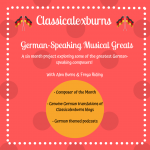Johann Strauss II: The Blue Danube
Context
Johann Strauss II’s perennially popular Blue Danube Waltz was composed in 1866 for a special concert on 15th February 1867 with the Vienna Men’s Choral Association. Although now firmly in the hall of fame of classical music, The Blue Danube received a rather neutral reception when premiered.
After the original version had been premiered, poet Joseph Weyl added words to the waltz. As the text was quite long, Strauss composed more music to the waltz. Strauss adapted a purely orchestral version, of which we enjoy today, for the 1867 Paris World’s Fair. This received a much better reception, with critics and audiences enjoying this new form The Blue Danube had taken.
Although the choral version is sometimes performed, more often than not it will be the extended orchestral version that is played regularly. The work is often heard as a concert opener or an encore.
The Music
In its entirety The Blue Danube takes between 8-10 minutes to perform. Opening with an extended introduction that hints at the famous theme, the shimmering strings add to the magical atmosphere. The iconic waltz theme is hinted by the horns and answered by staccato wind chords. The music swells, but quickly dies away into its restful character.
A quick contrast acts as a segue before the descending bass motif leads the orchestra into the iconic waltz melody. Strauss offers all instruments a chance to play the theme, passing the melody from the strings to the winds and then to the brass. The instruments are in a musical dialogue as the waltz tempo keeps the music swaying along.
A sequence of other waltzes are heard which develop the initial waltz theme. Strauss moves through different keys to add interest and excitement to each individual waltz. He glides through D major, Bb major and G major before touching on G minor before settling into F major.
A recap of the original waltz is heard near the end of the piece, which is now accentuated by the brass and percussion much more. The end is reflective in character, which is shown by Strauss’ thinner orchestration and use of certain solo instruments. The idyll is cut short as the waltz hurries back for a flourishing finale.
Final Thoughts
When performed live there is often an extra three minutes after the main waltz that orchestras perform the original waltz, with each repeat getting faster. It has now become quite the tradition in concert halls around the world. A truly iconic piece of music that has earned its place in the classical music hall of fame.
Ⓒ Alex Burns
Happy Reading!
You might also enjoy… Johann Strauss II: Tausend und eine Nacht
*This blog is part of the ‘German-Speaking Musical Greats Project’ 2019-20

Recommended Recordings:


0 Comments